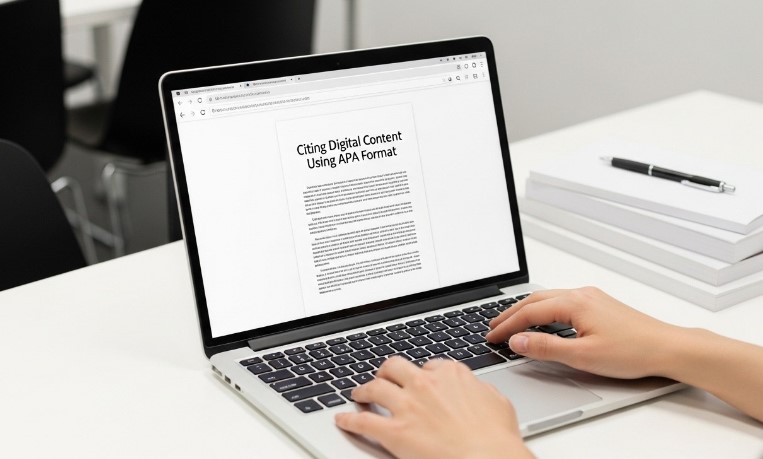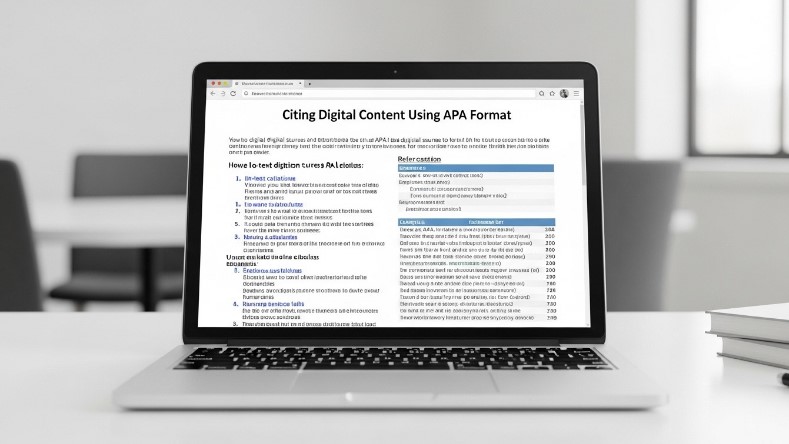APA style serves as a standardized method of crediting sources in academic and professional work.
Its use ensures clarity, consistency, and credibility in writing.
Proper citation of online materials is critical to prevent plagiarism and support transparency in sourcing information.
Table of Contents
ToggleGeneral Format for Online Citations

Citing digital content using APA format requires more than simply copying a URL. It involves organizing multiple citation elements consistently and logically.
The structure enables readers to locate sources easily while demonstrating the writer’s commitment to academic and professional integrity.
Proper formatting of these elements is not optional, it directly affects credibility and the readability of the work.
Writers must be meticulous in gathering citation details and aligning them according to APA standards. In digital environments where source material is constantly updated, this attention to detail ensures the citation remains accurate and meaningful over time.
Below are the core elements required in APA online source citations:
Author(s)
Begin with the surname followed by initials. If there is no individual listed, use the name of the organization or institution responsible for the content.
For multiple authors, use an ampersand (&) before the final name, and follow APA guidelines for listing up to 20 authors.
Publication Date
Enclosed in parentheses, the date follows the format (Year, Month Day) when available. If only the year is provided, that is sufficient.
Use “n.d.” to indicate no date when none is listed. Accuracy in dates helps readers assess the timeliness of the information.
Title of the Web Page or Document
Write the title in sentence case. Only the first word of the title, the first word after a colon or em dash, and proper nouns should be capitalized.
Do not italicize or use quotation marks.
Website or Complete Work Title
If the content is part of a broader website, include the site’s name in italics.
This helps clarify the larger source that the page or article belongs to, particularly when the content might otherwise seem disconnected or isolated.
Retrieval Statement
The retrieval statement should be written as “Retrieved [Month Day, Year], from [URL]”.
Including the retrieval date is especially important when citing pages that are updated regularly and do not have a clear publication date.
It shows exactly when the information was accessed, in case the content changes in the future.
Correct formatting of each of these elements is vital. Writers who rely on online material benefit significantly from mastering this citation structure.
The consistency achieved through APA’s format not only reinforces academic standards but also allows instructors, peers, and readers to validate the sources used without confusion or unnecessary effort.
Citing a Web Page or Website

When referencing a specific web page or an entire website, a series of precise steps ensures correct APA formatting.
- Step 1: Identify the author. Use an individual’s name if available; if not, name the responsible organization.
- Step 2: Find the date of publication or the last update. Some pages may not include this, but it is necessary to include it if present.
- Step 3: Record the exact title of the page or document. This should reflect the primary focus of the material being cited.
- Step 4: If the content exists as part of a broader site, include that website title in italics to clarify the larger source.
- Step 5: Provide the retrieval date and full URL, ensuring accessibility.
Example:
Harris, J. G. (1996). The return of the witch hunts. Witchhunt Information Page. Retrieved May 28, 1996, from http://liquid2-sun.mit.edu/fells.short.html
These steps are particularly useful for those who regularly need to ask themselves, “What is the right way to do my assignment online?” It is as accurate referencing improves academic credibility.
Citing an Article from an Online Database
When citing articles sourced through academic databases, APA style requires a citation structure that acknowledges both the traditional print elements of the source and the fact that the material was retrieved digitally.
Many academic assignments, research projects, and professional publications rely on these databases for peer-reviewed, scholarly content, which makes correct citation even more important for credibility and traceability.
Step #1
Begin by formatting the source just like a typical journal article or book. Include the names of the authors in inverted order (last name, followed by initials). Use an ampersand (&) before the final author’s name. Next, place the year of publication in parentheses.
Follow that with the title of the article using sentence case, capitalize only the first word and any proper nouns.
Then, italicize the title of the journal or publication, include the volume number (also italicized), and follow with the issue number in parentheses (if available), and the page range.
Step #2
If the article lacks traditional page numbers, a common occurrence in online-only publications, note this by writing “n. page” to indicate no pagination.
This tells readers that the article exists in digital format only and helps avoid confusion when they try to locate specific pages.
Wen possible, always double-check if a PDF version is available, which may still include page numbers.
Step #3
End the citation by identifying the database used to retrieve the article. For instance, names like PsycARTICLES, JSTOR, ProQuest, or EBSCOhost should be clearly stated.
Including the database name is vital for readers who may want to locate the article themselves, especially in academic environments where access is tied to institutional subscriptions.
Correct citation is not just a matter of formality, it ensures your work maintains academic standards and supports intellectual transparency.
Those who regularly do my assignment online, especially using institutional resources, must pay close attention to database names and access dates to avoid citation errors.
Example:
Borman, W. C., Hanson, M. A., Oppler, S. H., Pulakos, E. D., & White, L. A. (1993). Role of early supervisory experience in supervisor performance. Journal of Applied Psychology, 78, 443–449. Retrieved October 23, 2000, from PsycARTICLES database
In professional and academic contexts, following such formatting ensures that database-sourced information is both traceable and properly acknowledged.
The Bottom Line
Citing online sources accurately using APA format is essential for academic integrity and intellectual honesty.
Writers benefit from clear guidelines that structure citations consistently, allowing for greater trust in written work.
To minimize mistakes and ensure proper formatting, using official APA resources or trusted citation tools is strongly advised.



